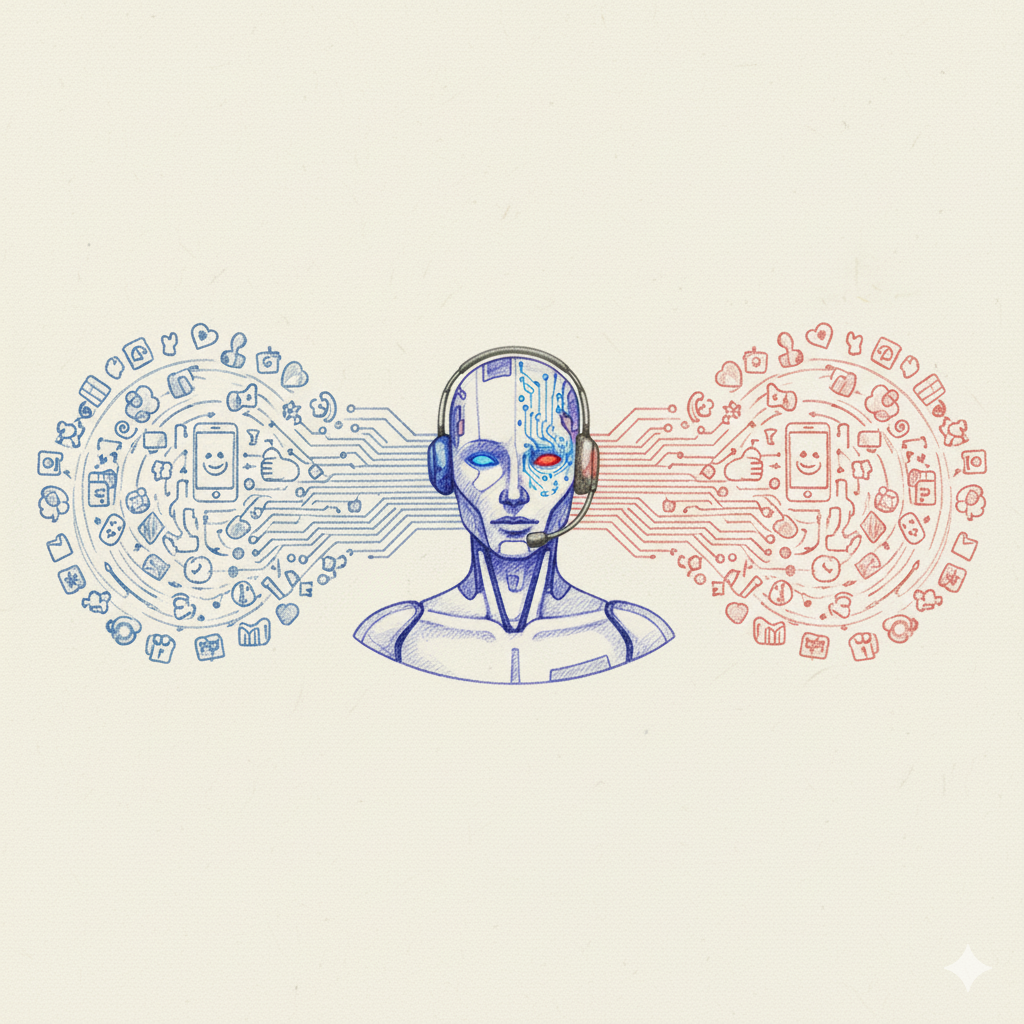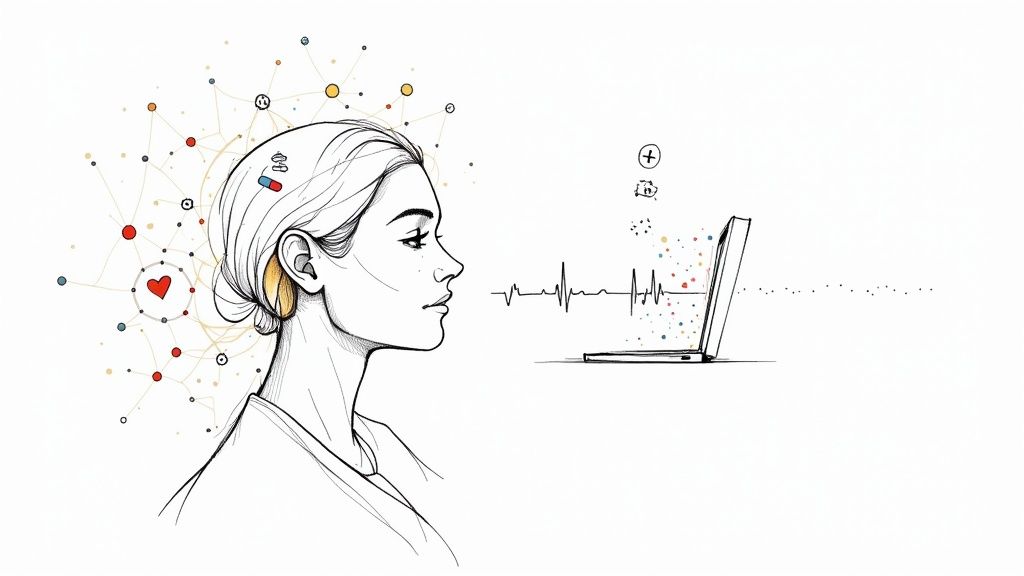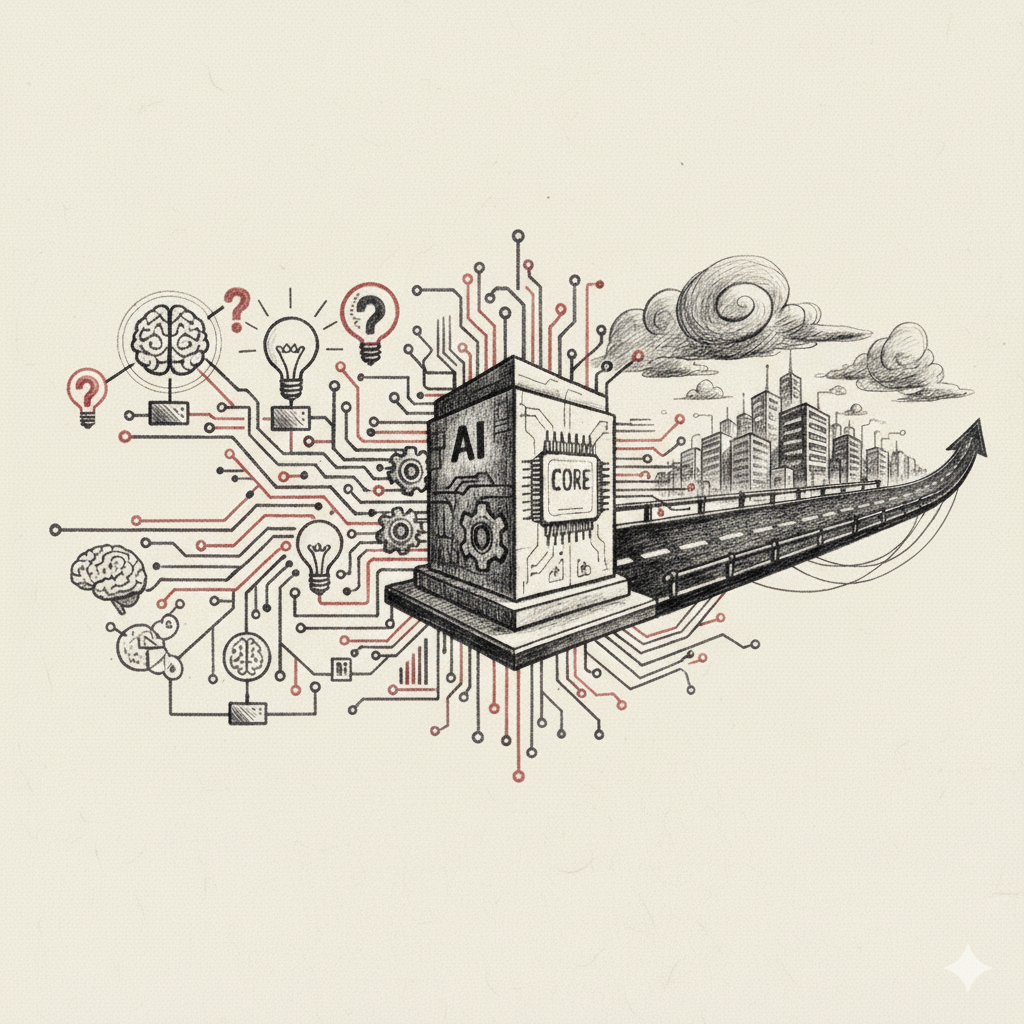Generative AI in MedTech A Practical Guide
Discover how generative AI in MedTech is transforming patient care and drug discovery. Learn about real-world use cases, benefits, and challenges.
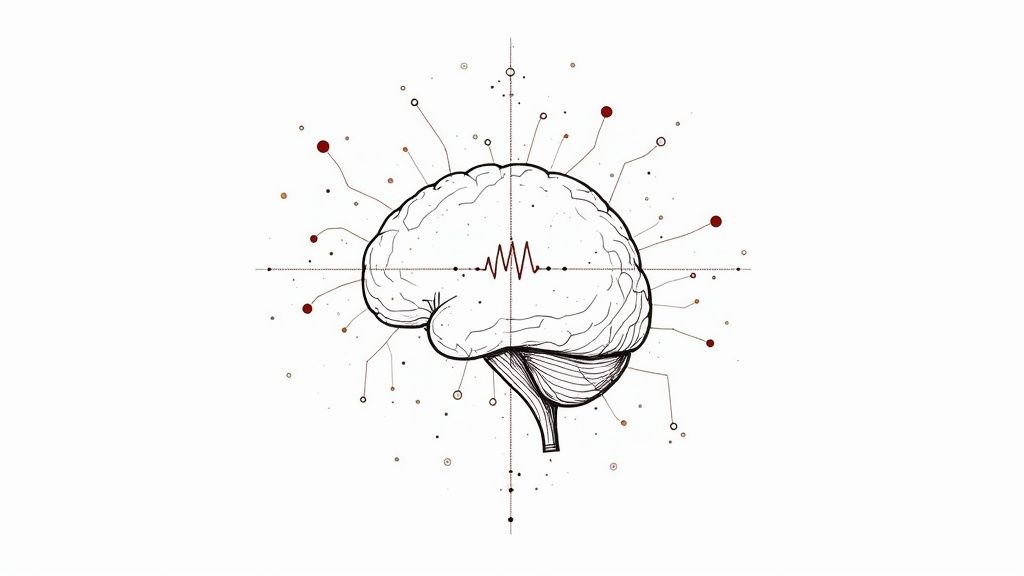
For a long time, generative AI in medicine felt like something out of science fiction. Not anymore. It's here now, actively changing how we approach patient care, medical research, and the day-to-day operations of clinics and hospitals.
This isn't just about small tweaks. The technology is unlocking entirely new ways of working, whether it's crafting personalized treatment plans from patient data or slashing the time it takes to discover new drugs. Crucially, it's also lifting a massive administrative weight off clinicians' shoulders, freeing them up to focus on what matters most: their patients.
How Generative AI Is Reshaping Medical Technology

So what does "generative" actually mean in this context? Think of it less like an analyst and more like a creator. Instead of just interpreting data, it generates brand-new, relevant content.
Imagine an intelligent partner that can draft a doctor’s clinical notes, design a novel molecule for a new drug, or even create clear, empathetic patient communications from complex medical records. It’s a tool that doesn't just analyze the past—it helps build the future of healthcare.
For any business leader in the MedTech space, getting a handle on this shift is no longer optional; it's a strategic necessity. The real work lies in building comprehensive AI Solutions that solve tangible problems.
The Fundamental Shift in MedTech
The arrival of generative AI is a true turning point for medical device companies. It’s changing the very DNA of how they operate and build products. We're already seeing leaders from giants like GE Healthcare and Philips talk about its power to make internal processes and workflows smarter and faster.
This is far more than just another software update. It's a foundational change that ripples through every stage of the product lifecycle, from the earliest R&D phases to how a device interacts with a patient.
Specifically, the technology opens up a few key opportunities:
- Automating Repetitive Work: It can take over the routine documentation and administrative tasks that bog down highly skilled professionals, giving them back time for critical thinking and patient care.
- Sharpening Clinical Decisions: It can sift through enormous datasets to find patterns and correlations humans might miss, presenting clinicians with data-backed insights to inform their judgment.
- Speeding Up Innovation: It helps break through development bottlenecks, enabling companies to create, test, and refine new medical technologies much more quickly without sacrificing safety or efficacy.
Here's a quick look at the main ways generative AI is making its mark on the industry.
Key Impacts of Generative AI in the MedTech Sector
A summary of the primary areas where generative AI is creating transformative value in the medical technology landscape.
| Area of Impact | Description of Transformation |
|---|---|
| Product Development | Accelerating R&D cycles by simulating new device designs, predicting material performance, and generating synthetic data for testing. |
| Clinical Operations | Automating the drafting of clinical notes, patient summaries, and regulatory paperwork, significantly reducing administrative overhead. |
| Diagnostic Accuracy | Enhancing medical imaging analysis (X-rays, MRIs) by highlighting potential anomalies and generating detailed diagnostic reports. |
| Personalized Medicine | Designing tailored treatment protocols and patient care plans based on an individual’s unique genetic, lifestyle, and clinical data. |
| Drug Discovery | Generating novel molecular structures and predicting their efficacy, dramatically shortening the timeline for new drug development. |
As you can see, the influence is broad, touching nearly every corner of the MedTech world and creating new avenues for growth and efficiency.
Why This Is a Strategic Imperative for Leaders
For leaders in the MedTech space, the conversation is no longer if they should adopt generative AI, but how and when. The trick is to be strategic about it. It’s about pinpointing the specific, high-value problems that this technology is uniquely suited to solve.
The ripple effects go far beyond the clinic, touching every part of the MedTech business model. You can see more concrete examples of these applications in our deep dive on AI for the healthcare industry.
By leaning into this technology with a clear plan, organizations can find new gears of productivity and innovation. A well-defined strategy is what turns these powerful capabilities from a talking point into real-world results that benefit both the bottom line and the patients you serve.
Building a Foundation in Medical AI
To really get a handle on what generative AI can do in MedTech, let's step away from the tech-speak for a moment. Instead, picture a medical resident who has somehow managed to read and perfectly remember every textbook, clinical trial, and research paper ever published. This AI "resident" doesn't just spit back facts; it connects the dots.
In seconds, this AI can scan a patient's entire medical history, spotting faint patterns that might point to a rare disease. It can also draft a clear, empathetic email to a patient explaining a complicated diagnosis, turning dense medical jargon into something a person can actually understand. The engine behind this is a Large Language Model (LLM).
But these aren't the same chatbots you see everywhere online. In the medical world, LLMs are put through a rigorous "med school" of their own. They're trained on massive, curated datasets—anonymized patient records, peer-reviewed studies, and the results of countless clinical trials. This specialized education is what gives them their clinical smarts.
From Data to Diagnosis
The real magic here isn't about regurgitating information. It's about generating something entirely new and relevant. Think about how a medical student learns to diagnose. They review case after case, internalize the principles of medicine, and then apply all that knowledge when they see a new patient with a unique set of symptoms.
A medical LLM works in a similar way. It chews through its training data to map out the intricate connections between symptoms, diseases, lab results, and treatments. When it sees a new patient's file, it draws on those learned patterns to create a list of potential diagnoses, recommend follow-up tests, or even sketch out a preliminary treatment plan for a human doctor to review and refine. This is the bedrock for building out a practical plan with AI strategy consulting that truly connects the technology to your organization's mission.
"Defining these approaches may help understand the associated benefits and risks with these new devices. What are the general problem statements that AI is trying to solve? What are the large language models (LLM) being used for the device? Does the LLM support the device's intended use case(s)?" – Insights from the FDA on AI in MedTech
The FDA's perspective gets to the heart of it: the quality of the AI's output is only as good as the data it was trained on and how well-defined the problem is. Garbage in, garbage out.
The Role of Specialized Training
A general-purpose AI, like the kind that powers a search engine, knows a little about a lot. That's great for trivia, but it's not nearly deep enough for medicine. That’s why generative AI in MedTech depends on models that are meticulously fine-tuned for specific clinical jobs. This training is non-negotiable for ensuring both accuracy and patient safety.
Here’s why that specialization is so critical:
- Medical Nuance: The model learns the subtle, contextual differences in medical language. It knows that "hypertension" and "hypotension" aren't just similar-sounding words, but polar opposites.
- Evidence-Based Reasoning: It can back up its suggestions by referencing the established medical literature it was trained on, showing its work just like a good clinician would.
- Task-Specific Skills: You can train one model to be an expert at summarizing doctor-patient conversations into clinical notes, another to flag anomalies in radiology reports, and a third to generate synthetic patient data for research.
Getting this foundation right is the first real step toward building AI Solutions that are both effective and responsible. Once MedTech leaders understand how these models actually learn and think, it becomes much easier to spot the real-world opportunities where this technology can make a genuine difference for clinicians and their patients.
A Look at Generative AI in MedTech Today
Alright, we've covered the basics. Now let's get into the exciting part—where generative AI is actually being used in MedTech. This is where the rubber meets the road, moving from abstract ideas to real tools that solve major problems for doctors, researchers, and patients. The applications are spreading fast, but they all share a common thread: helping human experts, cutting down on administrative headaches, and pushing medical science forward.
One of the first and most powerful applications to take hold is Ambient Clinical Documentation. Think of it as an AI-powered scribe that listens to a doctor-patient conversation and automatically writes up the clinical notes. This one application alone is giving clinicians back hours of their day.
But it doesn't stop there. Generative AI is also making huge waves in drug discovery, with algorithms creating brand-new molecular structures to get new treatments to market faster. It's also the engine behind personalized medicine, where it sifts through a patient's unique data to help design custom treatment plans. Each of these real-world use cases tackles a big challenge and delivers tangible results.
Giving Clinicians Back Their Time
The most immediate and celebrated use case for generative AI in MedTech is getting doctors away from their keyboards. Ambient clinical documentation has quickly become the technology's first "killer app."
In 2025 alone, this field is expected to hit $600 million in revenue, which is a massive 2.4 times increase year-over-year. What’s really telling is that startups are driving this wave, scooping up 85% of all generative AI spending in healthcare. That signals a huge innovation gap for the established players. The reason for the boom is simple: physicians often spend an hour on paperwork for every five hours they spend with patients. It's a problem so common it has a nickname: 'pajama time,' for all the evenings clinicians lose to catching up on notes. You can get the full picture by reading the complete report on the state of AI in healthcare.
This tech does more than just save time; it changes the entire dynamic of a doctor's visit.
- Better Patient Focus: Doctors can actually look at their patients and have a normal conversation, instead of staring at a screen and typing into an electronic health record (EHR).
- More Accurate Notes: The AI captures the whole conversation, so there's less risk of human error or forgetting to include important details in the medical notes.
- Less Clinician Burnout: It automates one of the most draining parts of the job, directly tackling a major cause of physician burnout.
This single application is a perfect example of how generative AI can deliver an immediate return on investment by fixing a widespread and expensive problem. A great real-world model of this is the Clinic AI Assistant, which handles these administrative tasks to make clinic operations run much more smoothly.
This map gives you a good idea of how generative AI takes raw medical data and turns it into something genuinely useful for doctors.
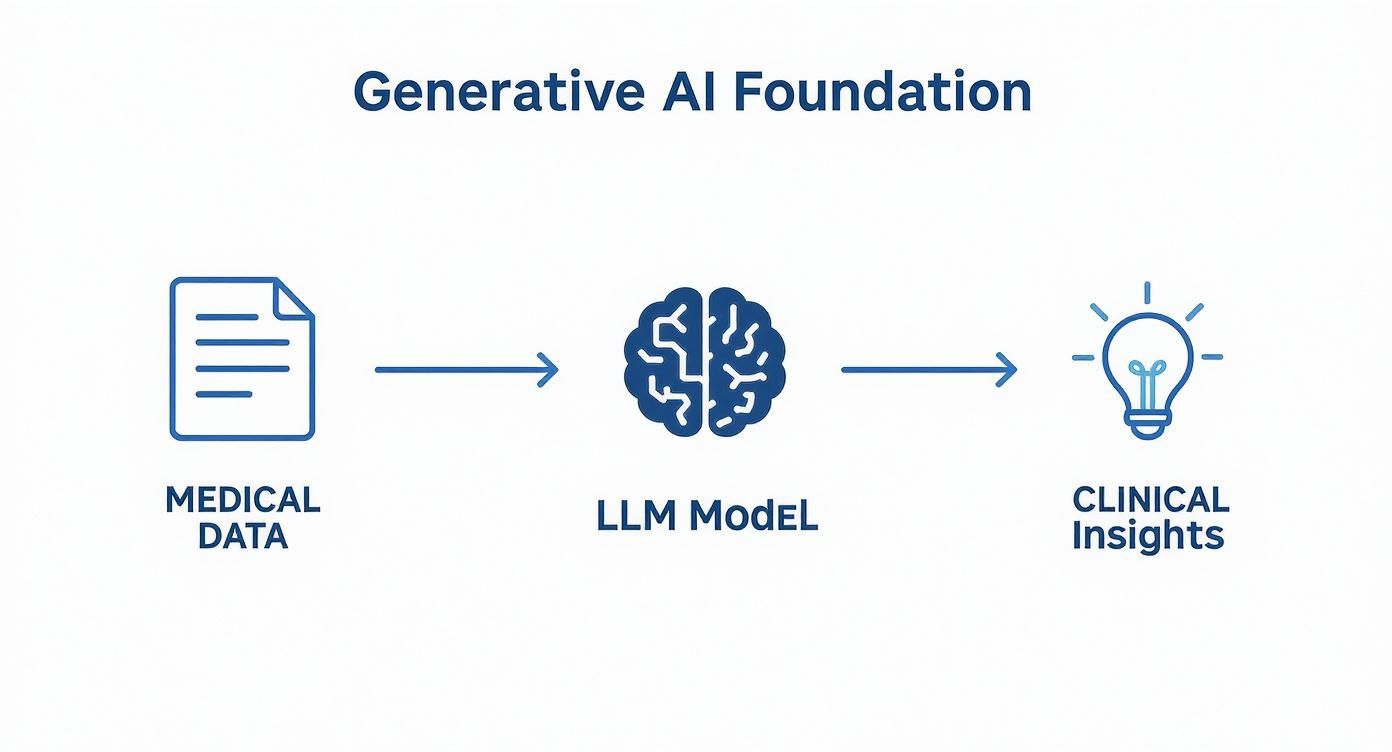
As the visual shows, raw medical data is the fuel. Large Language Models process it, synthesize it, and then produce valuable insights that clinicians can act on.
Speeding Up Drug Discovery and Research
Outside the clinic, generative AI is also transforming the lab. The traditional path to discovering a new drug is famously slow and costly—it can easily take more than a decade and billions of dollars to get a new therapy to market. Generative models are putting that timeline on fast-forward.
Instead of just testing millions of existing chemical compounds, these AI systems can design completely new molecules from the ground up. They can be built to target specific diseases with greater precision and fewer side effects. This approach, known as de novo drug design, lets researchers explore a universe of chemical possibilities that was simply out of reach before.
By generating novel hypotheses and designing new molecules, AI is not just speeding up the existing research process—it's creating entirely new avenues for scientific exploration.
Enhancing Medical Imaging and Diagnostics
Medical imaging is another field getting a major boost from generative AI. Radiologists and pathologists dedicate their careers to spotting tiny, tell-tale patterns in X-rays, MRIs, and tissue slides. Generative models can serve as a highly trained second set of eyes.
The impact here is twofold:
- Image Enhancement: AI can clean up and sharpen low-resolution or noisy scans. This makes it easier for doctors to see what’s going on without needing a second scan, saving time and reducing a patient's exposure to radiation.
- Synthetic Data Generation: One of the biggest roadblocks in training diagnostic AI is getting enough data, especially for rare diseases. Generative models can create an endless supply of realistic, anonymous medical images to train other AI systems, neatly getting around data scarcity and patient privacy issues.
From automating paperwork to designing life-saving drugs, generative AI is already proving its worth in MedTech. And these examples are just the tip of the iceberg, showing how this technology is becoming an essential partner in modern healthcare.
Seeing the Real-World Impact of AI in MedTech
When we talk about bringing generative AI into medtech, we're not just discussing futuristic concepts. We're talking about tangible results that are already hitting the bottom line, improving the lives of clinicians, and leading to better patient health. The benefits are creating a ripple effect across the entire healthcare system, making it smarter, faster, and more focused on the patient.
And the financial returns? They’re coming in surprisingly fast. A recent study found that over 80% of healthcare professionals saw AI drive up revenue at their organizations. What's even more impressive is that nearly half of them (45%) witnessed these gains in under a year. That’s an incredibly quick return on investment.
We’re seeing this wave of adoption led by practical tools like AI-driven clinical note generation (55%) and virtual assistants (53%). You can dig into more of this data in the 2025 healthcare AI report. This isn't just hype; it's a clear sign that strategic AI tools for business are becoming indispensable.
Making Healthcare Operations Run Smoother
One of the first things you’ll notice with generative AI is how it cuts through the operational clutter. The technology is brilliant at automating the tedious, repetitive admin work that burns out so many clinicians, creating a much more sustainable and productive environment for everyone.
Think about clinical documentation and medical coding. These tasks are absolutely essential for billing and records, but they eat up a huge amount of a doctor's time—time that should be spent with patients. With intelligent workflow automation, AI can listen in on a doctor-patient conversation, understand the medical jargon, and instantly generate clean, structured notes and codes. This isn't just about saving time; it's about reducing the chance of human error, which means more accurate billing and better compliance. The clinic runs more smoothly, and doctors can finally focus on care, not clicks.
Supercharging Research and Development
Generative AI is also shaking up the slow, costly world of medical R&D. In drug discovery, for example, AI algorithms can sift through massive biological datasets to pinpoint promising new drug candidates in a tiny fraction of the time it would take human researchers. Some models can even dream up entirely new molecular structures designed to hit specific therapeutic targets.
This speed boost isn't limited to pharmaceuticals. It’s also changing how medical devices are made. AI models can now:
- Simulate how a device will perform: Engineers can run thousands of virtual tests on a new device prototype without ever having to build a physical one.
- Create synthetic patient data: AI can generate realistic, anonymous data sets to train and validate new diagnostic tools, sidestepping tricky privacy issues and data shortages.
- Fine-tune clinical trials: These models can help predict how patients might respond to a treatment, making it easier to find the right candidates and design trials that are more likely to succeed.
By compressing these R&D cycles, medtech companies can get life-saving innovations into the hands of doctors and patients faster and more affordably. This is exactly what a well-thought-out AI Product Development Workflow is designed to achieve.
Driving Better Outcomes for Patients
At the end of the day, the most critical benefit of generative AI in MedTech is its direct impact on people's health. By making medicine more personal and predictive, AI gives clinicians the tools to make sharper diagnoses and craft more effective treatments.
Think of generative AI as a clinical co-pilot. It synthesizes huge amounts of patient data—genetics, lab results, history—to spot patterns and insights a human might miss. This partnership empowers doctors to make better, more informed decisions right there at the point of care.
For instance, an AI system can analyze a patient's unique genetic makeup, lifestyle, and medical history to recommend the absolute best treatment plan, moving us away from a one-size-fits-all approach. Predictive models can also flag patients who are at high risk for serious conditions like sepsis or heart failure, giving medical teams a chance to step in early and prevent a crisis. These aren't just marginal improvements; they lead directly to better health, longer lives, and a higher standard of care for everyone.
Navigating Implementation and Regulatory Hurdles
While the promise of generative AI in MedTech is huge, the road from a great idea to a real-world clinical tool is filled with serious challenges. For leaders in this space, making that leap requires a very practical, eyes-wide-open strategy for tackling the technical, ethical, and regulatory roadblocks ahead.
These aren't just minor speed bumps. Think of them as critical checkpoints that demand meticulous planning and execution. Getting this right is what separates a groundbreaking innovation from a costly compliance nightmare.
Safeguarding Patient Data and Ensuring Privacy
First and foremost, let's talk about data. Generative AI models need massive amounts of it to learn, and in healthcare, that data is about as sensitive as it gets. Protecting patient privacy isn't just a "nice-to-have"—it's a non-negotiable legal and ethical requirement, locked down by regulations like HIPAA.
Every single piece of data fed into a medical AI has to be thoroughly anonymized and secured. The trust between a patient and their doctor is the bedrock of healthcare, and any AI system has to be designed from the ground up to protect that trust, no exceptions. That means building a rock-solid security framework from day one.
Beyond just security, the integrity of the data itself is crucial. The reliability of your data directly impacts patient safety and your ability to meet regulatory standards. You'll need solid strategies to identify and prevent data integrity problems to make sure your AI models are built on a trustworthy foundation.
Confronting Algorithmic Bias
Another significant hurdle is the risk of algorithmic bias. At its core, an AI model is simply a mirror of the data it's trained on. If that data isn't diverse and representative of all the patient populations it's meant to serve, the AI can accidentally reinforce—or even worsen—existing health disparities.
Imagine an AI trained mostly on data from a single demographic. It might be far less accurate when diagnosing conditions in people from other backgrounds, potentially leading to wrong diagnoses and worse outcomes for underrepresented groups. Tackling this means consciously seeking out diverse datasets and constantly checking your models for fairness.
"A key focus for regulators is ensuring health equity for all patients. AI evaluations must take into account the diverse populations for which they are intended."
Taking these proactive steps is the only way to ensure the benefits of generative AI in MedTech reach everyone, not just a privileged few.
Decoding the Regulatory Maze
The regulatory environment for AI-powered medical devices is a tricky, shifting puzzle. Agencies like the FDA are trying to create clear pathways, but the technology is moving so fast that the rules are playing catch-up. Getting a new device approved isn't just about proving your algorithm works; it's about providing exhaustive documentation and validation.
Companies have to demonstrate that their AI systems are safe, effective, and dependable in the real world. This usually boils down to a few key things:
- Rigorous Validation: Proving the AI is accurate and consistent across different types of patients and clinical situations.
- Transparent Documentation: Explaining exactly how the model works, the data it was trained on, and where its limits are.
- A Clear Change Control Plan: Having a solid plan for how you'll update or retrain the AI over time without putting patients at risk.
Successfully navigating this maze takes deep regulatory know-how and a clear development roadmap from the start. If you're serious about turning an innovative concept into a compliant medical tool, getting help with the process can be a game-changer. Our team at Ekipa offers hands-on https://www.ekipa.ai/implementation-support to guide you through these complexities.
The Future of AI Integration in Medicine
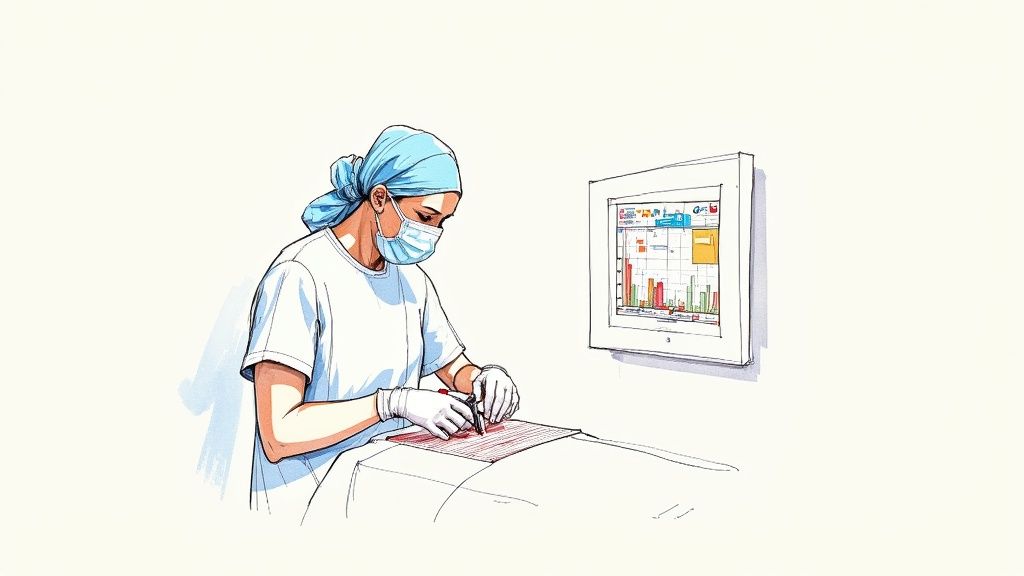
Looking down the road, generative AI in medtech is set to evolve from a helpful assistant into a core clinical partner. The real future isn't just about handing off tasks to a machine; it's about building a genuine symbiosis between the instincts of a seasoned medical professional and the analytical power of intelligent systems. This shift will kickstart an era of medicine that is more predictive, personalized, and precise than we've ever seen.
We're on the cusp of true hyper-personalized medicine. Imagine AI models crafting treatment plans that adjust on the fly, responding in real time to a patient's unique biological data. Think of therapies that constantly recalibrate based on live feeds from wearables and internal sensors, always optimizing for the best possible outcome. This future is being built right now through expert healthcare software development.
The Rise of Clinical Co-Pilots
Another massive leap forward will be the arrival of 'AI co-pilots' for surgeons and other specialists. These systems won't just sit in the background; they'll offer real-time guidance during complex procedures. They could analyze a live video feed from an operation to highlight critical anatomical structures or flag potential risks before they become problems. It’s not about replacing the surgeon's skill, but rather augmenting it with an incredibly vigilant and knowledgeable partner.
The development of sophisticated internal tooling will give MedTech organizations the power to build these custom AI applications in-house, tailored directly to their clinical needs and speeding up the pace of innovation.
Predictive Health and Proactive Interventions
But perhaps the most profound change will come from predictive health. We're moving toward generative models capable of simulating an individual's disease progression with startling accuracy. By running thousands of "what-if" scenarios, clinicians can pinpoint the most effective interventions long before a patient's condition becomes critical.
This future won't arrive everywhere at once, though. While generative AI usage in U.S. hospitals is expected to climb above 80–90% in major urban centers by 2025, smaller or rural hospitals are falling behind with adoption rates under 50%. This gap presents a major hurdle in making sure everyone has access to these powerful new tools. You can learn more about these AI adoption disparities in U.S. hospitals.
The future of medicine lies in a collaborative ecosystem where AI handles the massive scale of data analysis, freeing human experts to focus on the nuanced, compassionate aspects of patient care. This partnership is the key to unlocking the next generation of medical breakthroughs.
Ultimately, the goal is to weave generative AI in medtech so deeply into the clinical fabric that it becomes as fundamental as a stethoscope. It’s a vision where technology and humanity work in concert—a future our expert team is dedicated to helping organizations build today.
Frequently Asked Questions
What’s the biggest game-changer for generative AI in MedTech right now?
Right now, the most significant impact is happening in the exam room, where AI is tackling the massive problem of clinician burnout. Tools that can listen in on a patient visit and automatically draft the clinical notes are saving doctors hours of paperwork every single day.
This means physicians can finally look at their patients instead of a computer screen. It leads to better care, a stronger doctor-patient relationship, and far more accurate medical records. This use case has taken off so quickly because the return on investment for healthcare providers is immediate and obvious.
How can a MedTech company actually start using generative AI?
The first step is always having a clear plan. Don't try to boil the ocean. Instead, pick a high-value problem with a manageable scope—something like automating your internal documentation or speeding up the initial stages of research analysis. As we explored in our AI adoption guide, a focused pilot project is the best way to prove value and build momentum.
Getting a Custom AI Strategy report can give you a solid roadmap. For those looking to move faster, working with an AI Automation as a Service partner can get your project off the ground while making sure it lines up with your business and regulatory needs. It’s a smart way to dip your toes in the water without taking on massive risk.
What are the main ethical issues when using AI with patient data?
It really boils down to three core concerns: patient privacy, data security, and algorithmic bias. Protecting sensitive health information is paramount, which means ironclad compliance with regulations like HIPAA. All data has to be properly anonymized, encrypted, and managed with extreme care.
But the bigger, more subtle challenge is bias. If an AI model is trained on data that doesn't reflect the full diversity of the patient population, it can easily learn and even amplify existing health disparities.
Organizations have to be completely transparent about how their models work. This means rigorous testing, constant monitoring, and a commitment to ensuring the AI is fair and accountable. Building that trust with patients and regulators is absolutely essential.
Is generative AI going to replace doctors?
Not at all. The goal is to augment, not replace. Think of generative AI as a clinical co-pilot. It’s there to handle the tedious, data-heavy tasks so that medical professionals can focus on what they do best: critical thinking, human interaction, and making complex judgment calls.
This technology is a tool designed to make great doctors even better by clearing away the administrative noise and serving up helpful insights. The future of medicine is a collaborative one, where human expertise is amplified by intelligent systems. It’s a partnership that our expert team is helping organizations build every day.
Ready to define your place in the future of healthcare? Ekipa delivers tailored AI strategies and end-to-end execution to turn your vision into scalable impact. Discover how our AI Solutions can drive your MedTech innovation forward.

